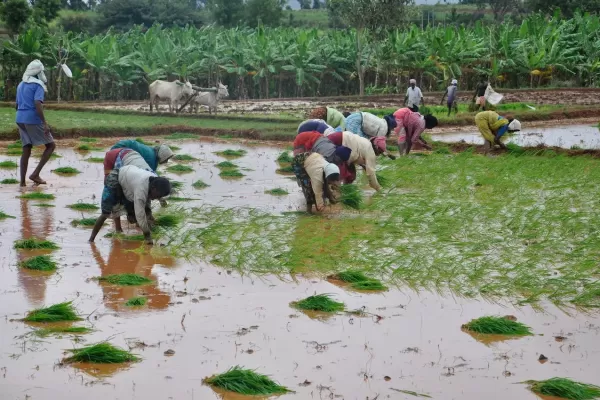Cultivating Change: The Evolution and Impact of Organic Farming in Agriculture

What is Organic Farming?
Organic farming is a sustainable path that avoids artificial chemicals and genetically qualified organisms. It emphasizes natural methods like crop revolution and composting to improve soil fertility and field pests. By prioritizing environmental health, biodiversity, and holistic farming practices, organic agriculture aims to produce food in an ecologically liable way and free from non-natural supplements.
Organic farming is a system that doesn't use fungicides or other harmful practices typical of artificial estates when growing works and raising creatures for food.
Evolution of Organic Farming
The origins of organic farming can be defined back to the early 20th century. The conception gained a boost in response to firms about the environmental and health impacts of synthetic fungicides and diseases that became more current during the Green Revolution. Still, it's essential to note that organic farming practices have literal roots in varied traditional and sustainable agricultural forms employed by different societies over centuries. The formalization and certification of organic farming began in the mid-20th century, labeling a more structured and honored way to sustainable agriculture.
What Are Organic Farming Methods?
Organic farming systems in agriculture grab maintainable trials that prioritize environmental charge, soil health, and the product of chemical-free, nutritional food. Crucial organic agriculture forms involve:
Crop Rotation
Alternating crops in an organized manner to help soil fertility, control pests, and reduce condition pressure.
Companion Planting
Growing mutually beneficial works to discourage pests, attract beneficent insects, and advance overall plant health.
Cover Cropping
Planting covers crops during ages of inactivity to defend and cultivate the soil, help corrosion, and help soil structure.
Organic Fertilization
Using natural sources similar to compost, waste, and organic amendments to give essential nutrients for plant growth.
Biological Pest Control
Introducing natural predators, spongers, or employing pest-resistant factory kinds to manage pest populations without synthetic fungicides.
Polyculture
Cultivating a different group of crops in the same area enhances biodiversity, reduces weakness to pests, and produces a more flexible ecosystem.
Agroforestry
Absorbs trees or shrubs into farming geographies to better soil structure, conserve water, and enhance sustainability.
Conservation Tillage
Minimizing soil disturbance during planting maintains soil structure, reduces waste, and enhances water retention.
Water Conservation
Implementing effective irrigation practices and water operation ways to conserve water funds.
Non-GMO Practices
Avoiding genetically modified organisms( GMOs) and favoring traditional,non-genetically altered crop kinds.
These approaches inclusively kick into the holistic principles of organic agriculture, seeking to produce a sustainable and environmentally friendly approach to farming that fosters soil health, biodiversity, and the overall well-being of the agriculture ecosystem.
Crop Diversity
Crop diversity refers to the Variety of other plant species and cultivars cultivated in a particular area or region. This diversity can include various crops, such as grains, fruits, vegetables, legumes, and different kinds within each class. The significance of crop diversity lies in promoting adaptability within agricultural systems.
The benefits of crop diversity include:
Inheritable Adaptability
Different crops and kinds hold varied inheritable traits, giving a buffer against conditions, pests, and environmental stress.
Ecosystem Stability
Diverse crops contribute to a more balanced ecosystem, reducing the threat of pest and complaint outbreaks while promoting natural bloodsuckers and beneficial organisms.
Nutritional Variety
A different array of crops leads to a more varied and nutritionally rich diet for humans and animals.
Adaption to Climate Change
Crop diversity allows for the selection and civilization of kinds more suited to changing climate conditions, contributing to long-term farming sustainability.
Preservation of Cultural Heritage
Multiple traditional and indigenous crops hold artistic and literal significance, and their protection helps maintain agricultural heritage.
Sweats to maintain and enhance crop diversity frequently involve practices like seed banking, conservation of heritage kinds, and the creation of sustainable farming systems that encourage the civilization of a wide range of crops. Overall, crop diversity is a fundamental aspect of flexible and defendable agriculture.
Renewable Resilience: A Focus on Renewables
Focusing on Renewable Resources in the Growth and Impact of Organic Farming in Agriculture" involves pressing the central part that maintainable and replenishable basics play in the development and influence of organic farming practices. Then is a crack-up of how this focus shapes the record.
Emphasizing Organic Inputs
Organic farming relies on renewable resources for its intakes. Unlike current agriculture, which frequently uses artificial diseases and pesticides, organic farming utilizes organic inputs like compost, manure, and top crops. These resources are renewable, gathered from natural processes, and kick into soil health and fertility.
Cyclical Nature of Renewable Resources
The blog will explore how organic farming operates within a cyclical framing. Renewable resources, like organic things and cover crops, are integrated into a maintainable circle. The yield remains representative, and green ordure from cover crops comes from organic matter that enriches the soil, creating an unrestricted and tone-nourishing system.
Breaking Dependency on Non-renewable Inputs
Organic agriculture minimizes reliance on renewable inputs like synthetic diseases and pesticides by focusing on renewable resources. This mitigates the environmental impact associated with the production and use of these inputs and aligns with the principles of long-term sustainability.
Enhancing Soil Health
The discussion would explain how the emphasis on renewable resources contributes to soil healthiness. Organic practices advance microbial diversity, enhance soil structure, and refine water retention, which is vital for a healthy and productive soil ecosystem. These benefits are sustained through the continued use of renewable resources.
Elevating Biodiversity and Environmental Harmony
Renewable resources in organic farming extend beyond just soil enrichment. The blog would explore how these resources contribute to biodiversity by eluding the use of synthetic chemicals dangerous to helpful insects and organisms. This, in turn, fosters a more harmonious relationship between farming and the terrain.
Profitable Viability and Long-term Sustainability
Focusing on renewable resources in organic farming is not just an ecological option; it's an economically feasible one. The blog could talk about how reduced dependence on external inputs and the civilization of a more flexible agricultural system kick into the long-term sustainability of organic farming practices.
Genetic Modification
Genetic modification involves altering an organism's genetic material, frequently achieved through advanced ways similar to CRISPR-Cas9. Genetic modification stands out differently in the environment of organic farming, which emphasizes natural processes and the avoidance of synthetic inputs.
While widespread agriculture has employed genetic modification to enhance specific crop traits, similar to resistance to pests or environmental stress, organic farming prioritizes holistic and natural styles for pest and complaint charge. Organic practices focus on principles like soil health, biodiversity, and avoiding synthetic diseases and pesticides.
The environmental impact of genetically modified organisms( GMOs) is controversial. While they may offer benefits similar to reduced pesticide use, concerns arise regarding implicit ecological dislocations and the development of resistant pests. Also, consumer enterprises about the safety of genetically modified foods contribute to the ongoing converse.
Organic farming, in discrepancy, positions itself as a sustainable choice. It relies on renewable resources, avoids synthetic inputs, and promotes soil health. The emphasis on traditional and natural farming practices aligns with specific consumer preferences.
Genetic modification and organic farming face norms and guidelines in the official geography. Numerous countries have shown rules to govern the discharge and consumption of GMOs, reflecting the ongoing efforts to balance technological advancements with environmental and safety considerations.
Looking ahead, as the world grapples with feeding a growing population, both genetic modification and organic farming are likely to attend. Each approach brings its unique benefactions and challenges, contributing to the ongoing development of agriculture in response to the imperative of sustainability and food security.
Posted
1 year ago
No comments yet! Why don't you be the first?










Add a comment